65996
m-Cresol
analytical standard
Synonim(y):
1-Hydroxy-3-methylbenzene, 3-Hydroxytoluene, 3-Methylphenol
About This Item
Polecane produkty
klasa czystości
analytical standard
Poziom jakości
gęstość pary
3.72 (vs air)
ciśnienie pary
<1 mmHg ( 20 °C)
Próba
≥99.0% (GC)
temp. samozapłonu
1036 °F
okres trwałości
limited shelf life, expiry date on the label
granice wybuchowości
1.06-1.35 %, 150 °F
metody
HPLC: suitable
gas chromatography (GC): suitable
współczynnik refrakcji
n20/D 1.541 (lit.)
n20/D 1.542
tw
203 °C (lit.)
mp
8-10 °C (lit.)
gęstość
1.034 g/mL at 25 °C (lit.)
Zastosowanie
agriculture
cleaning products
cosmetics
environmental
flavors and fragrances
food and beverages
personal care
format
neat
ciąg SMILES
Cc1cccc(O)c1
InChI
1S/C7H8O/c1-6-3-2-4-7(8)5-6/h2-5,8H,1H3
Klucz InChI
RLSSMJSEOOYNOY-UHFFFAOYSA-N
Szukasz podobnych produktów? Odwiedź Przewodnik dotyczący porównywania produktów
Opis ogólny
Find all available reference materials for compounds listed in 10/2011 here
Zastosowanie
Hasło ostrzegawcze
Danger
Zwroty wskazujące rodzaj zagrożenia
Zwroty wskazujące środki ostrożności
Klasyfikacja zagrożeń
Acute Tox. 3 Dermal - Acute Tox. 3 Oral - Aquatic Chronic 3 - Eye Dam. 1 - Skin Corr. 1B
Kod klasy składowania
6.1A - Combustible acute toxic Cat. 1 and 2 / very toxic hazardous materials
Klasa zagrożenia wodnego (WGK)
WGK 2
Temperatura zapłonu (°F)
186.8 °F - closed cup
Temperatura zapłonu (°C)
86 °C - closed cup
Środki ochrony indywidualnej
Faceshields, Gloves, Goggles, type ABEK (EN14387) respirator filter
Choose from one of the most recent versions:
Masz już ten produkt?
Dokumenty związane z niedawno zakupionymi produktami zostały zamieszczone w Bibliotece dokumentów.
Klienci oglądali również te produkty
Protokoły
Analytical standard separation of various phenols for research and industrial applications.
Nasz zespół naukowców ma doświadczenie we wszystkich obszarach badań, w tym w naukach przyrodniczych, materiałoznawstwie, syntezie chemicznej, chromatografii, analityce i wielu innych dziedzinach.
Skontaktuj się z zespołem ds. pomocy technicznej

![(R)-1-[(SP)-2-(Diphenylphosphino)ferrocenyl]ethyldicyclohexylphosphine ≥97%](/deepweb/assets/sigmaaldrich/product/structures/245/493/2ae2dd8a-65cc-4aba-9a1f-1292eb1ad8e0/640/2ae2dd8a-65cc-4aba-9a1f-1292eb1ad8e0.png)




![(R)-1-{(RP)-2-[2-(Diphenylphosphino)phenyl]ferrocenyl}ethylbis[3,5-bis-(trifluoromethyl)phenyl]phosphine ≥97%](/deepweb/assets/sigmaaldrich/product/structures/185/002/97358faf-b2d8-4de5-9315-73b6a8b3ae26/640/97358faf-b2d8-4de5-9315-73b6a8b3ae26.png)



